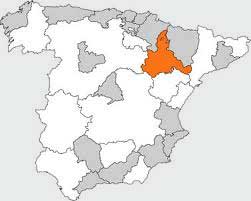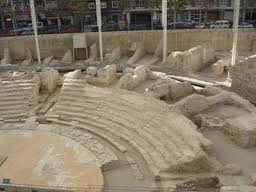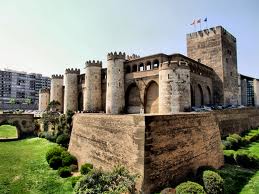
Zaragoza is lucky to be located in the middle of what is known as the geo-economic square, meaning it is between Madrid and Barcelona and between Valencia and Bilbao. Geographically, logistically and economically it is a prime spot. Adding to its favour is the fact that it lies on the fertile banks of one of Spain's biggest and longest rivers: the Ebro. This historic capital is the economic centre, and most populated city, of the Autonomous Community of Aragon. Bordered by France to the North, Valencia to the South, and to the west by Castile La Mancha, Castile-Leon, La Rioja and Navarra, this region is tremendous in size and scope.
Blessed with a brilliant mix of culture and stunning natural beauty, it has something to offer every type of tourist or traveller. This is a land where Roman ruins, ancient cathedrals, Muslim Mudejar, Medieval towns and castles on summits are surrounded by dense beautiful woodlands, heavenly valleys, dramatic desert plains and magical snow-capped mountains. The very nature of this diverse landscape makes it the perfect place from which to set out and try some of the best adventure sports in Europe, such as trekking, mountain biking, climbing, mountaineering, canoeing, kayaking, rafting, canyoning, skiing, snowboarding, and even dog sledding.
Zaragoza is in the centre of it all. Whether you are a sports enthusiast, a connoisseur of culture, a gastronomic guru, a fan of flora and fauna, or even an aficionado of archaeology, this is the perfect place to start off in seek of your adventure.
Zaragoza and the villages in and around the surrounding province are awash with history. Known as the city of four cultures, Zaragoza's fascinating legacy goes back some two thousand years- and its got the monuments to prove it. Evidence of the area's first people can be seen in the pre-historic cave paintings and megalithic Dolmens of the province. Traces of archaic Iberian settlements of Salduba, or Salduie (from the fifth century B.C.) can still be found in the Museum of Zaragoza.

Well preserved emblems of Zaragoza's next inhabitants - the Romans - can be seen throughout the old city centre; excellent examples include the underground Caesaraugusta Forum museum, the Caesaraugusta River Port Museum, the Caesaraugusta Public Bath Museum and the Caesaraugusta Theatre museum. In the old quarter, also known as the "Casco Viejo" or the "Coso", you can also find rare signs of Spain's once flourishing Jewish communities in places such as public baths, patios, castle premises, synagogues and a hospital.
The Muslims, who next ruled here for four centuries, left their unique mark in the form of the magnificent Mudejar architecture. There are many examples of these gems all over the city and province. The most remarkable of these is without a doubt the amazing Aljafería. Dating back to 1045, this palace has seen the likes of powerful Muslim sultans, medieval kings, the courts of the Spanish Inquisition and even a visit by the legendary Christopher Columbus.
As a reflection of its long and varied past, Zaragoza boasts an extensive amount of interesting and internationally recognized architecture. Structures standing out amongst all the rest, and the remarkable result of two cultures coexisting, are the magnificent UNESCO World Heritage Mudejar buildings. Mudejar is the name given to a decorative and artistic form of Christian-Muslim architecture. These ornate constructions were made by Arab craftsmen who, after the Christian re-conquest, were allowed to remain in Spain and keep their laws, religion and customs.

Using fairly cheap and easily obtainable materials, they decorated ceilings and walls with intricate brick work, plaster, wood, and glazed ceramic tiles. Adorning apses, towers, churches and all kinds of buildings with extensive geometrical shapes, intersecting archways, and beautiful bands of stone lacework. The result from this unique blend of Islamic tradition and Christian style was the construction and decoration of many truly original and valuable monuments. Most notable examples in Zaragoza include: the Aljafería Palace, the La Seo Cathedral, the church and tower of San Miguel, the church and tower of La Magdalena, the church and tower of San Gil, the Church and tower of San Pablo and the ceilings of the Town Hall.
One of the most important centres of pilgrimage in the Christian world and one of the things that Zaragoza is most famous for is the Basilica of Pilar. As the story goes, the year was 40 AD and a discouraged Apostle James was preaching on the banks of the river Ebro, when the Virgin Mary came, in person, to console him. It is on this very site that she placed a pillar, so that the first Marian church could be built. This same pillar remains inside the cathedral today topped with an opulent silver and gold statue of the Virgin. And wrapped in a "manta" (blanket) that is changed ceremoniously everyday. A section of this famous "pilar" (pillar) is open to the public, so that the thousands of people who come here every year can pay their tribute and even kiss it for good health, fortune and future.

To get the real feel for any Spanish city, it's always a good idea to watch the locals and do as they do. In a city that hasn't been flooded by hoards of holiday makers, we are given the perfect chance to "do what we see" and partake in the centuries old practise of "el tapeo"- going out for tapas. Zaragoza is a place well known as one of the best cities in Spain to go for tapas. On the list of this city's many sacred traditions, this delicious ritual is definitely way up there.
To start off your tapas crawl, head over to the area known as "el Casco" which is basically the old part of town. Turn off the busy shopping street of Don Jaime and go up Calle Mayor and tapas bars start appearing everywhere. Find your way to Santa Marta Square or San Miguel Square, where you will find two plazas packed with bars and bustling terraces full with people. For some of the best and most famous bars, wander your way through the maze of narrow streets and take it all in as you come across bar after bar, where one drink turns into another and each favourite takes the place of the other. You will find yourself doing as they do and loving every last minute of it.